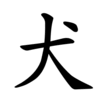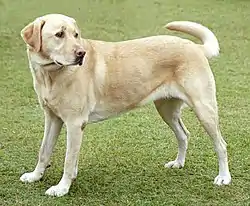犬
| ||||||||
| ||||||||
Translingual
| Stroke order | |||
|---|---|---|---|
 | |||
Alternative forms
- 犭 (when used as a left Chinese radical)
Although the alternative form clearly shows only three strokes, it is still counted as four strokes when using a Chinese dictionary. Compare 氵 from 水 (“water”), 扌 from 手 (“hand”), and 忄 from 心 (“heart”), all of which are 3-stroke forms from 4-stroke characters.
Han character
犬 (Kangxi radical 94, 犬+0, 4 strokes, cangjie input 戈大 (IK), four-corner 43030, composition ⿺大丶)
- Kangxi radical #94, ⽝.
Derived characters
References
- Kangxi Dictionary: page 705, character 27
- Dai Kanwa Jiten: character 20234
- Dae Jaweon: page 1118, character 14
- Hanyu Da Zidian (first edition): volume 2, page 1331, character 1
- Unihan data for U+72AC
Chinese
| simp. and trad. |
犬 | |
|---|---|---|
Glyph origin
| Historical forms of the character 犬 | |||||
|---|---|---|---|---|---|
| Shang | Western Zhou | Warring States | Shuowen Jiezi (compiled in Han) | Liushutong (compiled in Ming) | |
| Bronze inscriptions | Oracle bone script | Bronze inscriptions | Chu slip and silk script | Small seal script | Transcribed ancient scripts |
 |
 |
 |
 |
 |
 |
Etymology
From Proto-Sino-Tibetan *d-kʷəj-n (“dog”); cognate with Tibetan ཁྱི (khyi, “dog”), Burmese ခွေး (hkwe:, “dog”).
This common Sino-Tibetan word has been replaced by 狗 (OC *koːʔ) in most topolects except Eastern Min, such as Fuzhou kēng. In other topolects, this word is mainly found in compounds and not used alone.
Pronunciation
Definitions

犬
- (formal or in compounds or Eastern Min, Waxiang, dialectal Wu) dog
- 警犬 ― jǐngquǎn ― police dog
- 效馬效羊者右牽之;效犬者左牽之。 [Classical Chinese, trad.]
- From: The Book of Rites, c. 4th – 2nd century BCE
- Xiào mǎ xiào yáng zhě yòu qiān zhī; xiào quǎn zhě zuǒ qiān zhī. [Pinyin]
- He who is presenting a horse or a sheep should lead it with his right hand. He who is presenting a dog should lead it with his left hand.
效马效羊者右牵之;效犬者左牵之。 [Classical Chinese, simp.]
Synonyms
Compounds
- 使犬 (Shǐquǎn)
- 北極犬/北极犬
- 反犬旁 (fǎnquǎnpáng)
- 反犬旁兒/反犬旁儿 (fǎnquǎnpángr)
- 名犬
- 哮天犬 (xiàotiānquǎn)
- 喪家之犬/丧家之犬 (sàngjiāzhīquǎn)
- 嚮導犬/向导犬
- 土雞瓦犬/土鸡瓦犬
- 大犬星座
- 尋回犬/寻回犬 (xúnhuíquǎn)
- 小犬 (xiǎoquǎn)
- 德國狼犬/德国狼犬
- 惡犬/恶犬 (èquǎn)
- 悲犬咸陽
- 放鷹逐犬/放鹰逐犬
- 東門黃犬/东门黄犬
- 柴犬 (cháiquǎn)
- 桀犬吠堯/桀犬吠尧
- 淮南雞犬/淮南鸡犬
- 烹犬藏弓
- 牧羊犬 (mùyángquǎn)
- 犬不夜吠
- 犬儒學派/犬儒学派
- 犬兔俱斃/犬兔俱毙
- 犬吠之盜/犬吠之盗
- 犬吠之警
- 犬子 (quǎnzǐ)
- 犬彘
- 犬彘之食
- 犬戎 (Quǎnróng)
- 犬母
- 犬牙 (quǎnyá)
- 犬牙交錯/犬牙交错 (quǎnyájiāocuò)
- 犬牙差互
- 犬牙盤石/犬牙盘石
- 犬牙相制
- 犬牙相臨/犬牙相临
- 犬牙相錯/犬牙相错
- 犬牙鷹爪/犬牙鹰爪
- 犬馬/犬马 (quǎnmǎ)
- 犬馬之力/犬马之力 (quǎnmǎzhīlì)
- 犬馬之勞/犬马之劳 (quǎnmǎzhīláo)
- 犬馬之命/犬马之命
- 犬馬之報/犬马之报 (quǎnmǎzhībào)
- 犬馬之年/犬马之年
- 犬馬之心/犬马之心
- 犬馬之戀/犬马之恋
- 犬馬之疾/犬马之疾
- 犬馬之養/犬马之养
- 犬馬戀主/犬马恋主
- 犬馬齒殲/犬马齿歼
- 犬馬齒窮/犬马齿穷
- 犬馬齒索/犬马齿索
- 犬齒/犬齿 (quǎnchǐ)
- 狂犬病 (kuángquǎnbìng)
- 狼犬
- 獒犬
- 獵犬/猎犬 (lièquǎn)
- 獵犬座/猎犬座 (Lièquǎnzuò)
- 畫虎成犬/画虎成犬
- 畫虎類犬/画虎类犬 (huàhǔlèiquǎn)
- 盧犬/卢犬
- 粵犬吠雪/粤犬吠雪
- 義犬/义犬
- 聲色犬馬/声色犬马 (shēngsèquǎnmǎ)
- 臺灣犬/台湾犬
- 蜀犬吠日 (shǔquǎnfèirì)
- 蝴蝶犬 (húdiéquǎn)
- 見兔顧犬/见兔顾犬
- 警犬 (jǐngquǎn)
- 豚兒犬子/豚儿犬子
- 豚犬 (túnquǎn)
- 越犬吠雪
- 跖犬吠堯/跖犬吠尧
- 軍犬/军犬 (jūnquǎn)
- 邑犬群吠
- 野犬 (yěquǎn)
- 陶犬瓦雞/陶犬瓦鸡
- 雞犬不寧/鸡犬不宁 (jīquǎnbùníng)
- 雞犬不留/鸡犬不留
- 雞犬不驚/鸡犬不惊 (jīquǎnbùjīng)
- 雞犬俱升
- 雞犬升天 (jīquǎnshēngtiān)
- 雞犬桑麻/鸡犬桑麻
- 雞犬皆仙/鸡犬皆仙
- 雞犬相聞/鸡犬相闻
- 雞鳴犬吠/鸡鸣犬吠
- 顧犬補牢/顾犬补牢
- 飛鷹走犬/飞鹰走犬
- 驢鳴犬吠/驴鸣犬吠
- 鬆獅犬/松狮犬 (sōngshīquǎn)
- 鬥犬/斗犬
- 鷹犬/鹰犬 (yīngquǎn)
- 黃犬音/黄犬音
Descendants
- Bai: *qʰuaŋ²
References
- “犬”, in 漢語多功能字庫 (Multi-function Chinese Character Database), 香港中文大學 (the Chinese University of Hong Kong), 2014–
Further reading
- Victor Mair, "Of dogs and Old Sinitic reconstructions" on Language Log (March 7, 2018)
Japanese
Readings
Compounds
- 一犬 (ikken): one dog
- 雌犬 (mesuinu)
- 雄犬 (oinu), 牡犬 (oinu)
- 家犬 (ieinu)
- 野犬 (yaken)
- 子犬 (koinu), 小犬 (koinu), 仔犬 (koinu)
- 愛犬 (aiken)
- 犬ちゃん (inu-chan)
- 秋田犬 (Akita inu), 秋田犬 (Akita ken)
- 土佐犬 (Tosa inu), 土佐犬 (Tosa inu)
- 柴犬 (Shiba inu), 柴犬 (Shiba ken)
- 猟犬 (ryōken)
- 狛犬 (komainu)
- 狩猟犬 (shuryōken)
- 警察犬 (keisatsuken)
- 攻撃犬 (kōgekiken)
- 三頭犬 (santōken)
- 犬張子 (inuhariko, “papier-mâché dog doll”)
- 老犬 (rōken): old dog
- 豚犬 (tonken): pig and dog; fool; my child
- 犬吠 (kenbai): the barking of a dog, or the sound thereof
- 駄犬 (daken): mongrel dog
- 雑犬 (zakken): mongrel dog
- 番犬 (banken)
- 警備犬 (keibiken)
- 探知犬 (tanchiken)
- 救助犬 (kyūjoken)
- 死体犬 (shitaiken)
- 麻薬犬 (mayakuken)
- 放火犬 (hōkaken)
- 盲導犬 (mōdōken)
- 聴導犬 (chōdōken)
- 介助犬 (kaijoken)
- 犬猿の仲 (ken'en no naka)
- 犬神 (inugami)
- 山犬 (yamainu)
- 鬣犬 (tategamiinu): hyena
- 犬歯 (kenshi, “canine tooth”)
Etymology

| Kanji in this term |
|---|
| 犬 |
| いぬ Grade: 1 |
| kun’yomi |
| Alternative spelling |
|---|
| 狗 |
From Old Japanese, from Proto-Japonic *enu. Derivation uncertain. Various theories exist, including derivation from ancient verb 往ぬ (inu, “to leave, to be gone”), from the way a dog will guard the house while the master is away; from a compound of 家 (ie, “house, home”) + 寝 (nu, “to sleep”, ancient monosyllabic form of modern 寝る neru); from ancient Japanese 狗 (enu < wenu, “puppy, dog”), itself of uncertain derivation; or as a borrowing from some other unknown language.
Noun
Usage notes
- As with many terms that name organisms, this term is often spelled in katakana, especially in biological contexts (where katakana is customary), as イヌ.
Descendants
- → Yami: ino
References
- Matsumura, Akira, editor (2006), 大辞林 [Daijirin] (in Japanese), Third edition, Tōkyō: Sanseidō, →ISBN
- NHK Broadcasting Culture Research Institute, editor (1998), NHK日本語発音アクセント辞典 [NHK Japanese Pronunciation Accent Dictionary] (in Japanese), Tōkyō: NHK Publishing, →ISBN
Korean
Etymology
From Middle Chinese 犬 (MC khwenX).
| Historical Readings | ||
|---|---|---|
| Dongguk Jeongun Reading | ||
| Dongguk Jeongun, 1448 | ᄏᆑᆫ〯 (Yale: khyyěn) | |
| Middle Korean | ||
| Text | Eumhun | |
| Gloss (hun) | Reading | |
| Hunmong Jahoe, 1527 | 가히〮 (Yale: kàhí) | 견〯 (Yale: kyěn) |
Pronunciation
- (SK Standard/Seoul) IPA(key): [kjʌ̹n]
- Phonetic hangul: [견]
Derived terms
Northern Amami-Oshima
Okinawan
Pronunciation
- IPA(key): [ʔiŋ̍]
Compounds
- 犬子 (ingwā, “puppy, small dog”)
References
- “いん【犬】” in JLect - Japonic Languages and Dialects Database Dictionary, 2019.
Southern Amami-Oshima
Vietnamese
References
- Nguyễn et al. (2009).
- Trần (2004).
- Bonet (1899).
- Génibrel (1898).